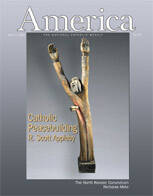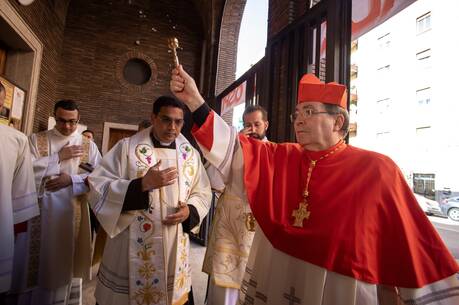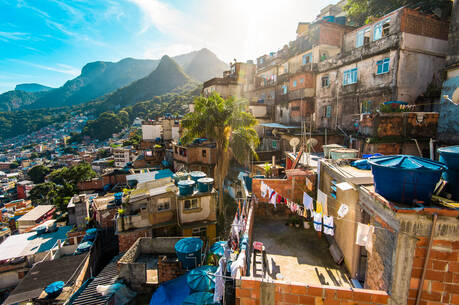A major theme sounded by the Bush administration before and after the war against Iraq is the right and responsibility of the United States, as the world’s leading democracy, to unseat the forces of tyranny and replace dictatorial regimes with democracies wherever U.S. interests are threatened. In a speech delivered on Feb. 26, President Bush articulated the moral underpinnings of this doctrine. “Human cultures can be vastly different,” he acknowledged, “yet the human heart desires the same good things everywhere on earth.” As the postwar experience in Iraq suggests, however, there is reason to doubt that those “good things,” including political self-determination, can be imposed from above and from the outside.
How do societies ravaged by conflict move toward stability based on respect for human rights, social justice and the rule of law? The church has something quite concrete to offer to the debate. Last year Caritas Internationalis published Peacebuilding: A Caritas Training Manual. Distributed to the confederation of 154 Catholic relief and development agencies in 198 countries that comprise Caritas, the text is a companion piece to Working for Reconciliation: A Caritas Handbook (1999).
The manual and handbook reflect the new orientation of the transnational Catholic social service apostolate. The church now strives to extend its preferential option for the poor beyond relief and charity, beyond social and economic development, toward “reconciliation.” The handbook describes this: “a longer term process of overcoming hostility and mistrust between divided peoples...[and of promoting] the consolidation of constructive social relations between different groups of the population, including parties to the conflict.”
The turn to the reconciliation of peoples and groups was triggered by the experience of Catholic Relief Services and other Caritas member agencies working in settings of post-cold war conflicts. During the 1990’s in Rwanda, Bosnia, Sudan, Algeria, Nigeria, India and countless other host countries, deadly violence erupted within national borders among ethnic, religious and cultural groups. Relief and development efforts could no longer be undertaken in isolation from cultural and communal dynamics. Nor could Catholic agencies continue to underplay their distinctive strengths as faith-based nongovernmental organizations (namely, the church’s century-old tradition of teaching on social and economic justice) and the natural affinity of Catholic-based transnational organizations with local Catholic churches and other religious elements within the host societies.
Accordingly, in the mid-90’s C.R.S. reviewed its mission through a “justice lens” crafted from Catholic social teaching. Projects are now evaluated, in part, according to how they reduce or eliminate structural injustices in the host society. More recently, as indicated by the appearance of the reconciliation handbook and the peacebuilding manual, Caritas Internationalis has forged a “peacebuilding lens.”
What must be developed, the handbook continues, are cohorts of indigenous peacebuilders—agents for nonviolent change who, as members of the society experiencing strife, have a vested and long-term interest in applying their irreplaceable “local knowledge” to the task of reconciliation. Such local and regional conciliators have become essential actors, “because peace settlements do not bring about the required change of heart, which is the crux of peace, particularly in complex internal conflicts.”
Peacebuilding precedes and follows upon peacemaking. The conflict mediators and diplomats, if they are successful, bring a halt to the killing and abuse, at least temporarily, through negotiated settlements and political solutions. By defusing immediate tensions, they make peace possible. Peacebuilders, however, make peace real—they work over months, years and decades to sustain the peace, to transform nonviolent conflict resolution and, where possible, reconciliation, into a way of life. “The principle of indigenous empowerment suggests that conflict transformation must actively envision, include, respect and promote the human and cultural resources from within a given setting,” writes the peacebuilding scholar-practitioner John Paul Lederach. “This involves a new set of lenses through which we see the setting and the people not as the problem and the outsider as the answer. Rather, we understand the long-term goal of transformation as validating and building on people and resources within the setting.”
Lederach, one of the lead authors of the new Caritas manual, is a Mennonite who gained prominence as a creative and insightful conceptualizer of the peacebuilding trajectory and practice. In recent years, as Catholics have put their own peacebuilding house in order, Lederach has gravitated to Catholic circles in response to what he calls “admiration of Catholic verticality.” By this he means that the Catholic Church’s pervasive worldwide presence and its hierarchical structure ensures that the practitioner of peacebuilding will find potential Catholic allies across the globe, in one conflict zone after another, embedded at each level of society. Cardinals, archbishops and wealthy or influential lay Catholics are found among the elites of society; Catholic intellectuals and cultural leaders, influential priests and religious, and Catholic N.G.O.’s operate in crucial mid-level leadership positions; and priests, religious and laity ministering to and teaching in the towns, villages and parishes constitute important elements of the grass roots. These potential partners are natural allies because they are committed in principle both to social justice and to peacemaking.
The qualifying words “potential” and “in principle” suggest that the ubiquitous Catholic presence at various levels of some societies does not automatically translate into a coherent or compatible company of peace and justice allies. Church members do not always subscribe to the same ideology or theology of peace and justice. And even where one finds common purpose and harmony, if not perfect consensus, among Catholics occupying different social positions within “the vertical church,” another problem arises: one hand often does not know what the other is doing.
And yet the overall picture is encouraging, the potential astounding. The Caritas handbook alone lists over 120 organizations working around the world in conflict resolution (not all of them are Catholic, but most are partners or potential partners). It profiles 24 “examples of good practice in reconciliation” conducted by Catholics and their nongovernmental partners in the field. Such exemplary practices include trauma healing in Croatia; human rights advocacy in Guatemala; conflict prevention and mitigation in Ahmedabad, India; Muslim-Christian peacebuilding workshops in Mindanao, Philippines; education for peace in Egypt; and conflict resolution training in Sierra Leone. The church universal, in short, is thriving in its mission to civil society.
How does Catholic peacebuilding work? There is no comprehensive model; each concrete situation requires its own diagnosis and response. Ideally, however, the Catholic peacebuilder’s approach to transforming conflict draws upon the strengths of Catholicism as a worldview and as an institution. Thus, to take the case of the Philippines, Catholic peacebuilding in recent years has drawn upon both local and trans-local actors. While engaging local Muslim and Christian leaders in one-on-one dialogue and in conflict resolution workshops aimed at developing constructive social relations among the populations affected by the conflict, peacebuilders also draw on the good offices of the universal church, in this case through transnational N.G.O.’s like C.R.S., which provide mediators and consultants to the process. Sensitive to the cultural and religious particularities of Mindanao, Catholic peacebuilding has been ecumenical and interreligious in orientation; it is not exclusively Roman Catholic. Not least, the process, in the best Catholic tradition, is not isolated from national political and economic conditions and actors, including politicians, diplomats and policymakers upon whose decisions the hope for stability, a crucial ingredient in a peacebuilding process, often rests.
But the process in Mindanao, as elsewhere, is incomplete. Although Catholic peacebuilders are now present at every stage of the conflict transformation cycle, they are scattered across the globe. They work in peace education and conflict prevention, in mediation and conflict resolution, in postsettlement social reconstruction, and in the academies and courts where human rights, including religious freedom, are given theoretical depth and cross-cultural grounding. The training grounds for Catholics seeking entry into this emerging world of peacebuilding increasingly include the local parish and inner-city ministries of reconciliation and conflict resolution. But the full range of abilities and skills—and the people who possess them— are not concentrated in Mindanao or in other sites. The next step is to marshal all of these resources for each conflict setting.
One also finds encouragement in lay movements such the Community of Sant’Egidio, whose work of disciplined friendship and service to the poor and marginalized, coupled with the professional background and political and religious access of the members, has made the community an international leader in conflict mediation and transformation. Catholics are collaborating in new and productive ways with government and nongovernmental organizations, and with other religious bodies. The Center for Mission Research and Study at Maryknoll, for example, has recently published a study of grass-roots peacemaking among Christians that was conducted in collaboration with Presbyterian researchers in the Sudan and Northern Ireland. Both the Maryknoll Center and the United States Institute of Peace are contemplating ways to advance Christian-Muslim understanding and dialogue on the grass-roots and middle levels of society. The Catholic peacebuilder might also find an institutional partner in the World Conference on Religion and Peace, which brings local religious and cultural leaders together in chapters dedicated to joint initiatives promoting the building up of inter-ethnic, interreligious cultures of nonviolence.
Ideally, this new dimension of Catholic peacemaking engages grass-roots and middle-range leaders and elites in a coherent, coordinated strategy; it draws upon the Catholic Church’s great strength as a hierarchical, transnational, multicultural institution and community; and it does all this with a heightened level of intentionality and self-awareness and a striving for coherence that may be possible only in the kind of globalized, high-tech, communications-immersed and cyberspace-driven world we now inhabit.
The list of ideas and peacebuilding initiatives is dizzying. While there is great wisdom in letting a thousand flowers bloom, there is also strength and success through communication and coordination of efforts. Better communication up and down and across the pyramid would serve to consolidate and thus conserve resources and energies, and it would enhance the opportunities for collaboration and sharing of resources, including field experiences and the insights and stories cultivated from them.
Catholic verticality, Lederach laments, is largely an untapped resource. Too frequently the efforts of the hierarchy and their colleagues are uninformed about what is happening, or could be happening, at the grass roots. Even more disabling is the failure to develop and use the crucial “middle management”—the Catholic administrators, intellectuals, public servants, N.G.O.’s, etc.—who could serve as the organic link between elite peacemakers and the local peacebuilders. On the other hand, some Catholics worry about a tendency toward overmanagement and the replication of secular-bureaucratic, instrumentalist model.
In order to address these concerns and promote the development of Catholic peacebuilding as a conceptually coherent, theologically sophisticated and spiritually enlivening dimension of the church’s mission to the world, a group of Catholic scholars, researchers, pastoral ministers, missioners and peace and justice practitioners recently formed a Catholic Peacebuilding Network. Catholic Relief Services, the United States Conference of Catholic Bishops, the Center for Mission Research and Study at Maryknoll, Pax Christi, the Community of Sant’Egidio and several Catholic colleges and universities are represented in this first phase of organization, with the hope of welcoming new members over time.
The C.P.N. hopes to invite and encourage Catholic relief and development workers, Catholic academics and other Catholic intellectuals and artists, Catholic public servants, administrators, journalists and others from conflict-ridden societies (including the United States) to join the network and contribute to a series of meetings, summits and joint projects designed to enhance communication and increase collaboration.
The rich history of Catholic spiritual practices and traditions of wisdom must be made available to peacebuilders in various cultural settings. This effort to wed spirituality to social transformation is informed by the Catholic “both/and.” Conversion of the peacebuilder’s heart toward deeper and deeper appropriation of the Gospel of peace, justice and forgiveness is the ultimate good that may follow from the work. At the same time, efforts by professionals trained in conflict resolution advance authentic human flourishing through the building up of peaceable relations among peoples.
Peacebuilding is a vocation rooted in the Catholic sacramental and anthropological worldview, but is also inherently ecumenical, interreligious and open to the secular world. To say that Catholic peacebuilding is sacramental means, among other things, that grace—God’s own life, shared by us—informs and shapes our encounter with our neighbors in need in every concrete situation, so that the work of justice and peacemaking contains a depth dimension beyond, and undergirding, the visible and material. Catholic anthropology, by giving human freedom a decisive role in responding to the divine offer of redemption, calls Catholics to collaborate with God, so to speak, in healing hearts, establishing justice, making peace—and thereby ushering in the kingdom of God.
Accordingly, Catholic peacebuilders approach the collaborative and technical aspects of building peace with the conviction that Christ has already redeemed the world and calls us to be signs of, and witnesses to, that truth. This conviction, in turn, shapes every necessary but imperfect attempt to designate and strive to achieve concrete outcomes—social or political consequences—of peacebuilding.









RENEW International has been working in Rwanda since 1999 helping bishops in their efforts to establish a pastoral strategy based on faith-sharing in small Christian communities. One of those is the bishop of Ruhengeri in the northwest of the country. The Diocese of Ruhengeri was one of the areas that suffered most horrifically from the civil war in Rwanda, which started in 1992, the genocide of 1994 and its aftermath. Its bishop, several priests and many religious were murdered, the last being Guy Pinard, M.Afr., a Canadian missionary priest.
Bishop Kizito Bahujimihigo of Ruhengeri, who succeeded his murdered predecessor, has stated that he views the work of RENEW International in his diocese as one of the most important attempts at reconciliation between ethnic factions that he has seen in Rwanda. RENEW workers in Rwanda do not mention the words “genocide” or “reconciliation” but try to help Christians read the Scriptures, reflect and act upon their inspiration as small communities.
I welcome the creation of the Catholic Peacebuilding Network and am grateful for the leadership both Caritas and C.R.S. have provided in this important area. May I take this opportunity to thank the C.R.S. office in Kigali for their continuing support of our work in Rwanda.
On the other side of Africa, in Nigeria, the State of Kaduna has witnessed strife between Christians and Moslems with appalling loss of life, especially since March 2000. The archbishop of Kaduna has invited RENEW to come and help Christians of his diocese establish small Christian communities, which would, among other things, explore ways to reduce religious strife between Christians and Moslems and improve relations between the two groups.